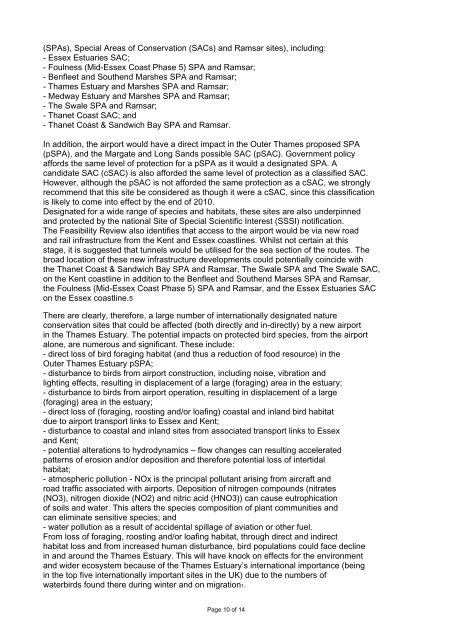1. Ecological objections - London
1. Ecological objections - London
1. Ecological objections - London
Create successful ePaper yourself
Turn your PDF publications into a flip-book with our unique Google optimized e-Paper software.
(SPAs), Special Areas of Conservation (SACs) and Ramsar sites), including:<br />
- Essex Estuaries SAC;<br />
- Foulness (Mid-Essex Coast Phase 5) SPA and Ramsar;<br />
- Benfleet and Southend Marshes SPA and Ramsar;<br />
- Thames Estuary and Marshes SPA and Ramsar;<br />
- Medway Estuary and Marshes SPA and Ramsar;<br />
- The Swale SPA and Ramsar;<br />
- Thanet Coast SAC; and<br />
- Thanet Coast & Sandwich Bay SPA and Ramsar.<br />
In addition, the airport would have a direct impact in the Outer Thames proposed SPA<br />
(pSPA), and the Margate and Long Sands possible SAC (pSAC). Government policy<br />
affords the same level of protection for a pSPA as it would a designated SPA. A<br />
candidate SAC (cSAC) is also afforded the same level of protection as a classified SAC.<br />
However, although the pSAC is not afforded the same protection as a cSAC, we strongly<br />
recommend that this site be considered as though it were a cSAC, since this classification<br />
is likely to come into effect by the end of 2010.<br />
Designated for a wide range of species and habitats, these sites are also underpinned<br />
and protected by the national Site of Special Scientific Interest (SSSI) notification.<br />
The Feasibility Review also identifies that access to the airport would be via new road<br />
and rail infrastructure from the Kent and Essex coastlines. Whilst not certain at this<br />
stage, it is suggested that tunnels would be utilised for the sea section of the routes. The<br />
broad location of these new infrastructure developments could potentially coincide with<br />
the Thanet Coast & Sandwich Bay SPA and Ramsar, The Swale SPA and The Swale SAC,<br />
on the Kent coastline in addition to the Benfleet and Southend Marses SPA and Ramsar,<br />
the Foulness (Mid-Essex Coast Phase 5) SPA and Ramsar, and the Essex Estuaries SAC<br />
on the Essex coastline.5<br />
There are clearly, therefore, a large number of internationally designated nature<br />
conservation sites that could be affected (both directly and in-directly) by a new airport<br />
in the Thames Estuary. The potential impacts on protected bird species, from the airport<br />
alone, are numerous and significant. These include:<br />
- direct loss of bird foraging habitat (and thus a reduction of food resource) in the<br />
Outer Thames Estuary pSPA;<br />
- disturbance to birds from airport construction, including noise, vibration and<br />
lighting effects, resulting in displacement of a large (foraging) area in the estuary;<br />
- disturbance to birds from airport operation, resulting in displacement of a large<br />
(foraging) area in the estuary;<br />
- direct loss of (foraging, roosting and/or loafing) coastal and inland bird habitat<br />
due to airport transport links to Essex and Kent;<br />
- disturbance to coastal and inland sites from associated transport links to Essex<br />
and Kent;<br />
- potential alterations to hydrodynamics – flow changes can resulting accelerated<br />
patterns of erosion and/or deposition and therefore potential loss of intertidal<br />
habitat;<br />
- atmospheric pollution - NOx is the principal pollutant arising from aircraft and<br />
road traffic associated with airports. Deposition of nitrogen compounds (nitrates<br />
(NO3), nitrogen dioxide (NO2) and nitric acid (HNO3)) can cause eutrophication<br />
of soils and water. This alters the species composition of plant communities and<br />
can eliminate sensitive species; and<br />
- water pollution as a result of accidental spillage of aviation or other fuel.<br />
From loss of foraging, roosting and/or loafing habitat, through direct and indirect<br />
habitat loss and from increased human disturbance, bird populations could face decline<br />
in and around the Thames Estuary. This will have knock on effects for the environment<br />
and wider ecosystem because of the Thames Estuary’s international importance (being<br />
in the top five internationally important sites in the UK) due to the numbers of<br />
waterbirds found there during winter and on migration<strong>1.</strong><br />
Page 10 of 14
















